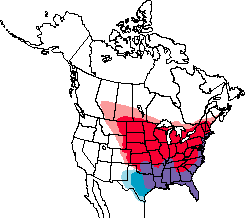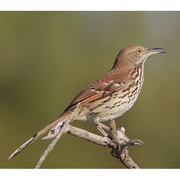Brown Thrasher
Toxostoma
rufum
Passeriformes
Members of this diverse group make up more than half of the bird species worldwide. Most are small. However their brains are relatively large and their learning abilities are greater than those of most other birds. Passerine birds are divided into two suborders, the suboscines and the oscines. Oscines are capable of more complex song, and are considered the true songbirds. In Washington, the tyrant flycatchers are the only suboscines; the remaining 27 families are oscines.
Mimidae
The Mimids compose a relatively small New World family. Well known for their elaborate vocalizations and mimicry abilities, they often sing repeated phrases within their extended songs. Mimids are medium-sized songbirds with strong legs, long bills, and gray or brown plumage. Many have streaked or spotted breasts. Most forage on the ground, and use their long bills to dig in the soil. They seldom form flocks, and are found in pairs or family groups. They eat a combination of animal and vegetable matter, with more insects and other invertebrates in the diet in the spring and summer, and more nuts and berries in the fall and winter. They usually nest in dense, low shrubs, and both parents help build the nest, incubate, and care for the young.
General Description
Accidental spring and fall migrant on both sides of Cascades, one winter record from Spokane County.
North American Range Map







